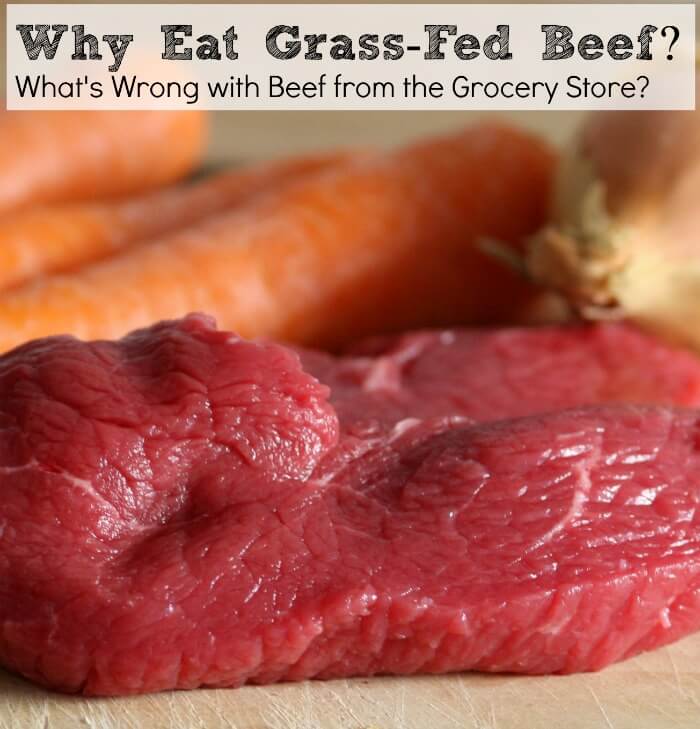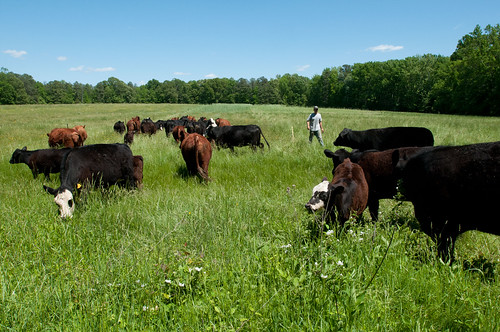Your Own Beef Vs Grocery Store Beef
Several months ago we purchased a grass-fed and -finished cow. I made lots of calls trying to find the best deal on buying a cow, but buying a grass-fed and -finished cow costs substantially more than a grain-fed cow, no matter how you slice it (the pun is intentional). Despite the extra expense, I decided the health benefits were worth the cost. I'd rather reap the savings at the doctors office than in the grocery store.
If you're looking for a good source of grass-fed meat, Butcher box has high-quality meat that they will deliver right to your door. If you use this link to Butcher Box, you can get $15 off your first box and FREE bacon(!!).

What's Wrong with Beef from the Grocery Store?
The beef that you're purchasing from the grocery store (you know, the kind on the styrofoam plates with the plastic wrap on top, or in the plastic tubes) is vastly different from the grass-fed meat you can purchase from a local farmer. The primary difference is in how the cow was raised. Your standard grocery store beef has been was raised on a feedlot.

When cattle is raised on a feedlot, they are provided a mostly grain-based diet. A grain-based diet causes health problems for cows because cows are ruminants: they are designed to digest grass, not corn and soy derivatives. Being on a grain-based diet greatly increases the risk of them carrying e. coli and other pathogens due the change of pH in their gut. Begin grain-fed also decreases the nutritional value of the meat.
Because of their poor diet and cramped living quarters, they're prone to health problems, so they're almost constantly on antibiotics. Many farmers routinely keep their cows on antibiotics which have caused problems with antibiotic resistant strains of bacteria.
You may be surprised to find there are a number of very undesireable ingredients that make their way into animal feed (read this startling article from the Environmental Health Perspectives journal, "What Do We Feed to Food-Production Animals? A Review of Animal Feed Ingredients and Their Potential Impacts on Human Health"). Animal feed can include: meat from animals of other species or meat from the same species, roadkill, meat from diseased animals, bits of feathers, hair, skin, hooves, blood, manure and other animal waste, plastics, drugs, chemicals, and unhealthy amounts of grain.
Remember the old adage, "You are what you eat." Well, so is the cow…and you're eating that cow…which means all of that garbage the cow ate is now going into you. That's pretty gross!
So why do farmers feed animals grains and other undesireables if it creates diseased cows and meat with low nutrients and high levels of toxins? It all comes down to the bottom line. Farmers feed the cattle this diet because it fattens them up more quickly. Also, grain-based feed is cheap because the government subsidizes farmers who grow corn and soy. So, now you know why grain fed meat is cheaper: the farmers can raise them quickly and feed them cheaply.
The Wonders of Grass-Fed Beef
Must we all forgo juicy hamburgers and succulent steaks if we are to avoid these health pitfalls? Never fear my carnivorous friends, there is a very healthy alternative to grocery store meat, but it will take a little more work and money to get your hands on it. There are many benefits of finding a local farmer who raises grass-fed and grass-finished beef.
Grass-fed beef has been raised on what cows were designed to eat: grass! As such there are a plethora of health benefits in eating a grass-fed and grass-finished cow.
- Though the meat tends to be lower in total fat, there is a greater concentration of omega-3 fatty acids. Grain-fed beef is virtually deplete of all omega-3s. Omega-3 fatty acids are essential for human health, but our body cannot synthesize them on our own. The standard American diet is quite deficient in omega-3's. You eat Omega 3 fatty acids in algae, fish oil, grass-fed meat, and flax seed oil (though our bodies do not utilize the omega-3's in flax seeds as well as in meat sources).
- Grass-fed beef is the richest known source of conjugated linolic acid (CLA), which has been found to have many health benefits. CLA has anti-cancer properties and increases cardiovascular health. Grass-fed beef has approximately 300-500% more CLA than a cow that is fed half grains.
- The meat your get from a grass-fed cow has much less chance of being infected with e. coli and other diseases.
- A grass-fed cow is much higher in b vitamins, vitamin k and e, as well as essential trace minerals. In fact, many experts report that the bio-available (what your body can actually use) vitamins and minerals that are in meat vastly outweighs that which is found in fruits and vegetables.
Things to Keep in Mind
You need to remember that organic does not mean grass-fed and -finished. Most organic beef is still, at a minimum, finished on a feedlot with organic feed.
When talking to farmers you need to verify that they are both grass- fed and grass- finished. A farmer can label their meat "grass-fed" even if they fatten the cow up with grain the last couple of months. You want to find a grass-finished cow for an optimal level of nutrients! When farmers finish their cows off with grain to quickly fatten them up the last few months of their life, there is a drastic reduction in vitamins and minerals.
Finally, I've heard some report that they had a bad experience with grass-fed beef. It just didn't taste good. I'm sure there are less than optimal tasting grass-fed cows, just as there are grain-fed cows. But being the foody that I am, I can happily report my family and I have been exceedingly pleased with the taste of our grass-fed cow. We've been so happy with it we're anxiously awaiting a pastured pig from the same farmer!

Source: https://www.intoxicatedonlife.com/why-we-eat-grass-fed-beef-or-whats-wrong-with-meat-from-the-grocery-store/
0 Response to "Your Own Beef Vs Grocery Store Beef"
Post a Comment